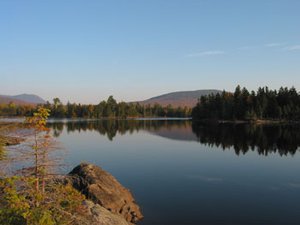Moosehead Lake
|
|
Mapmoosehead.jpg
Moosehead Lake is a lake lying in the Longfellow Mountains in Maine on a elevation of 312 m (1,023 ft). It is approx. 40 by 10 miles (64 by 16 km). It is the largest lake in Maine, offering over 400 miles (640 km) of shoreline.. It has an area 311 km² (120 mile²), and is the source of the Kennebec River.
Moosehead geography
Moosehead Lake's major tributary is the Moose River. East of Jackman the Moose River flows through Long Pond to Brassua Lake. The Roach River drainage, to the east of Moosehead Lake, is Moosehead's second largest tributary. Flowing out of Moosehead to the southwest are its East and West Outlets
Nestled among the tree covered mountains, Moosehead Lake is the second largest lake east of the Mississippi in one state (behind Florida's Lake Okeechobee). Moosehead Lake's island studded waters stretch as far as the eye can see until its blue is swallowed by the dark green of the surrounding forest. There are over 80 islands in the lake, the largest being Sugar Island.
Towns that border the lake include Greenville, Maine to the south and Rockwood to the northwest.
Mount Kineo, with 700 foot (200 m) cliffs rising straight up from Moosehead Lake, is an unforgettable setting that has lured people for centuries. Native Americans once traveled great distances to Mt. Kineo, relying on its flint-like rhyolite to make stone tools. In recent centuries, Kineo's spectacular scenery and the amenities of Moosehead Lake drew "rusticators" and summer guests to vacation at the base of this imposing precipice. Other species as well appreciate this unusual geological formation: peregrine falcons and an assemblage of rare plants rely on Mt. Kineo's cliffs and steep talus slopes.
The Moosehead Lake Region encompasses 4,400 square miles (11,000 km²) of West Central Maine, and includes 127 townships plus Moosehead Lake. The region is drained by 330 miles (530 km) of main stem rivers, into which flow 3,850 miles (6,200 km) of smaller tributaries. During the last glacial era more than 1,200 natural lakes and ponds were carved into its landscape, varying in size from one acre (4,000 m²) ponds to Moosehead, at 74,890 acres (303 km²) Maine's largest lake, and one of the largest natural freshwater lakes in the United States. The total area of all standing surface waters in the region is more than 238,000 acres (963 km²) - 24% of the total area of lakes and ponds in Maine.
Because it lies at the headwaters of the Kennebec, the West Branch of the Penobscot, the Piscataquis, the Pleasant, and the St. John rivers, the Moosehead Region has experienced fewer biological and physical changes than other areas in Maine. Anglers will find, and enjoy much of the natural beauty described by Thoreau and other nineteenth century visitors to the region.
Moosehead history
The Moosehead region has enjoyed a long and often colorful history. Often, when visitors come to the area, they are heard to talk about the pristine wilderness environment found here, suggesting perhaps that the area is just now being "discovered." But that is far from the truth because-there were people here long before the early explorers reached the area. In fact, it was Moosehead Lake's direct link with the Kennebec River and close proximity to the West Branch of the Penobscot River that made the area vital to the earliest inhabitants. Not much is known about the earliest inhabitants, Indians during the early Archaic Period about 10,000 years ago. They didn't keep written records, but stories were passed down from generation to generation, now lost to the sands of time. However, there are many artifacts from the period about 3,000 to 6,000 years ago, and they indicate these people traveled by water and hunted big game. These inhabitants became known as "Red Paint People" because of the red ochre found in the excavated graves of these early people. There were gravesites of Red Paint People near the Mt. Kineo Hotel on the Kineo Peninsula across from Rockwood, but the graves were virtually destroyed many years ago when tennis courts were constructed at the site. Artifacts from these graves were on display at the hotel for many years, and others were taken to Boston and the Peabody Museum.
Moosehead2.jpg
The Red Paint People left the area or died out and it was not until about 1,000 years ago that other various tribes came to the region. It is generally believed that most of the Indians in Maine were Algonquins who migrated from Canada. In Maine, Indians are often known by geographic areas which more clearly defined tribes. The tribes which frequented the Moosehead region included the Cannebis (or Kennebecs), the Piscataquis, Penobscot, Saint Francis, and perhaps less frequently, the Micmac and Maliseet. Soon, Indians lived at various locations around Moosehead Lake, including Seboomook, Northeast Carry, Indian Hill in Greenville, Birch Point in Rockwood and at Kineo. In fact, early Indians were perhaps the first tourists to come to the region, traveling to Mt. Kineo for the excellent silicious hornstone, also known as flint. Much of Mt. Kineo is flint, and Indians were known to travel great distances to secure the stone which was essential for their arrowheads, spearheads, tomahawks and other weapons and implements. In fact, the stone is so different that scientists have been able to track Mt. Kineo flint across much of the eastern United States and Canada. Indians which came to the area for flint included the St. Francis, Norridgewocks, Abenakis, Delawars, Mohawks and Iroquois.
For the most part, Indian life was difficult but peaceful. Perhaps the most significant problems occurred when the Mohawks came to the region for flint. They were bitter enemies of the Abenakis, and it is believed that many a battle was fought in the woods surrounding Moosehead Lake.
External link
- Moosehead Historical Society (http://www.mooseheadhistory.org/)

